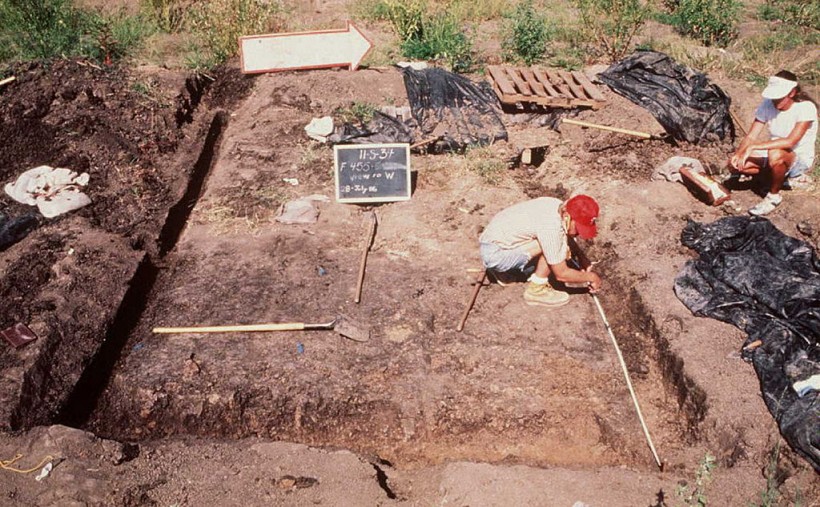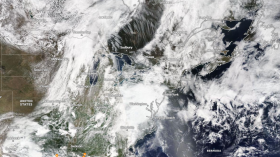Generations ago, Cahokia was known as the largest and most influential urban settlement of the Mississippian culture. The hustle and bustle, thriving metropolitan area was home to over 15,000 citizens.
While it was once a radiant city, research teams don't seem to be completely understand the other side of the story, as by the later part of the 14th century, the land has been rarely visited by people.
The Radiant City of Cahokia Abandoned Hundreds of Years Ago

EDWARDSVILLE, KS - JANUARY 19: This undated photo provided by the Southern Illinois University Geography Department from Edwardsville,IL,shows archaeologists working at a site near St. Louis,MO,which they believe to be "City of the Sun", an ancient Cahokia Indian city which vanished without a trace 800 years ago. After years of exhaustive study,researchers believe that they have discovered Monks Mound,a-14 acre 100-foot high earthen structure which was built entirely with stone tools.
A report conducted previous year manage to prove one of the many earlier theories which was that destruction of the forest and exploitation of the open field near Cahokia produced severe damage and localized floods, rendering the location uninhabitable for Indigenous Inhabitants of America.
By analyzing rock samples collected around earthen structures at the Cahokia Mounds Regional National Monument, investigators discovered that the land stayed prominent from Cahokia's glory until around the 1800s and rapid industrialization
Under alternative utterances, there has been no humanitarian calamity.
According to the interview of geoarchaeologist Caitlin Rankin of the College of Illinois at Urbana published at the media site, ScienceAlert, there were a fairly widespread story concerning agricultural management patterns that rise to degradation and deposition and make a significant contribution to all of these ecological repercussions.
However, while expert go back over this hypothesis, they can't find any indication of devastating floods.
The mounds that the archaeological location was near to are in low-lying regions beside a watercourse which is a great location for any localized inundation that could have occurred.
Nevertheless, the investigation issued on the journal Geoarchaeology in the year of 2021, demonstrated that this didn't contribute to the type of degradation and floods that will also force inhabitants from their dwellings.
"There have been indications of excessive timber usage throughout the occurrence. However, this does not take into account the possibility that individuals may incorporate things in the same way that they can reprocess." Rankin stated in a news release at the time.
Also read: Africa's 'Killer Lake' Kivu Hides a Deadly Poison Cloud Gas That May Erupt, Risk Millions
About 15,000 Inhabitants of Cahokia Left, Reason Remains Unknown
Researchers also advice the people to not make the assumption that habitat destruction was occurring or that this incident was ended up causing by habitat destruction.
With research reported in 2020 that investigated antiquated fecal matter to posit that human beings must have officially proceeded to come back to Cahokia in significant figures long already when European native people arrived in the 16th era, experts continue to be fascinated by Cahokia,
According to the researchers conducting the 2021 research, though it's critical to continue searching to discover real proof of what transpired, the shambles we're creating of caring for the world right now renders it so much simpler to picture environmental destruction becoming accountable for some of history's unanswered puzzles.
In previously published news from The Source, no one knows for sure why people left Cahokia, though many environmental and social explanations have been proposed. Ruling out previous hypothesis, experts are forced to look for alternative answers and seek new paths of inquiry as remarked by Tristram Kidder, an anthropologist at Washington College in St. Louis.
Also read: Experts Explain Why Clouds Work Differently Between Earth's Hemispheres
© 2024 NatureWorldNews.com All rights reserved. Do not reproduce without permission.



![Venomous Centipede Could be Game-Changer and Save Lives of People with Kidney Disease [Study]](https://1471793142.rsc.cdn77.org/data/thumbs/full/70407/280/157/50/40/venomous-centipede-could-be-game-changer-and-save-lives-of-people-with-kidney-disease-study.jpg)

